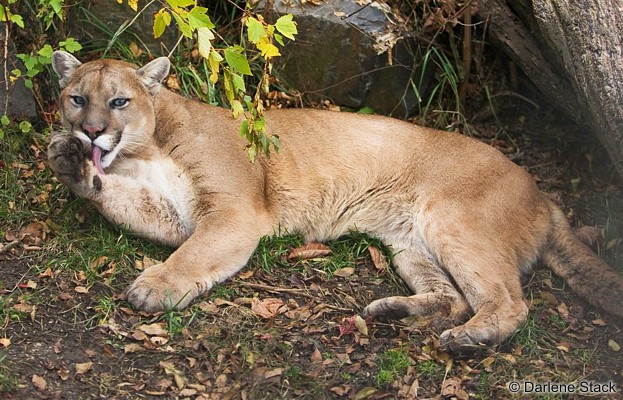Post by dinosauria101 on May 21, 2019 9:25:44 GMT 5
Mountain Lion - Puma concolor
The mountain lion (Puma concolor), also known as puma, cougar, mountain cat, catamount or panther, depending on the region, is a mammal of the family Felidae, native to the Americas. This large, solitary cat has the greatest range of any large wild terrestrial mammal in the Western Hemisphere, extending from Yukon in Canada to the southern Andes of South America. An adaptable, generalist species, the mountain lion is found in every major American habitat type. It is the second heaviest cat in the American continents after the jaguar. Although large, the mountain lion is most closely related to smaller felines. Mountain lions are slender and agile cats. They are the fourth largest cats and adults stand about 60 to 76 centimeters (2.0 to 2.5 ft) tall at the shoulders. The length of adult males is around 2.4 meters (8 ft) long nose to tail, with overall ranges between 1.5 and 2.75 m (5 and 9 ft) nose to tail suggested for the species in general. Males typically weigh 53 to 100 kilograms (115 to 220 pounds), averaging 62 kg (137 lb). Females typically weigh between 29 and 64 kg (64 and 141 lb), averaging 42 kg (93 lb). Mountain lion size is smallest close to the equator, and larger towards the poles. The largest recorded mountain lion was shot in Arizona and weighed 125.5 kilograms (276 pounds) after its intestines were removed, indicating that in life it could have weighed nearly 136.2 kilograms (300 pounds). Several male mountain lions in British Columbia weighed between 86.4 and 95.5 kilograms (190 to 210 pounds).

Roosevelt Elk - Cervus canadensis roosevelti
The Roosevelt elk (Cervus canadensis roosevelti), also known as Olympic elk, is the largest of the four surviving subspecies of elk in North America. They live in the rain forests of the Pacific Northwest and were introduced to Alaska's Afognak and Raspberry islands in 1928. Adults grow to around 6–10 ft (1.8–3 m) in length and stand 2.5–5 ft (0.75–1.5 m) tall at the shoulder. Elk bulls generally weigh between 700 and 1100 lb (300–500 kg) while cows weigh 575–625 lb (260–285 kg). Some mature bulls from Raspberry Island in Alaska have weighed nearly 1300 lb (600 kg). From late spring to early fall, Roosevelt Elk feed on herbaceous plants such as grasses and sedges.[4] During winter months, they feed on woody plants including highbush cranberry, elderberry, and Devil's Club. Roosevelt Elk are also known to eat blueberry, mushrooms, and salmonberry.

Credit to Wikipedia
The mountain lion (Puma concolor), also known as puma, cougar, mountain cat, catamount or panther, depending on the region, is a mammal of the family Felidae, native to the Americas. This large, solitary cat has the greatest range of any large wild terrestrial mammal in the Western Hemisphere, extending from Yukon in Canada to the southern Andes of South America. An adaptable, generalist species, the mountain lion is found in every major American habitat type. It is the second heaviest cat in the American continents after the jaguar. Although large, the mountain lion is most closely related to smaller felines. Mountain lions are slender and agile cats. They are the fourth largest cats and adults stand about 60 to 76 centimeters (2.0 to 2.5 ft) tall at the shoulders. The length of adult males is around 2.4 meters (8 ft) long nose to tail, with overall ranges between 1.5 and 2.75 m (5 and 9 ft) nose to tail suggested for the species in general. Males typically weigh 53 to 100 kilograms (115 to 220 pounds), averaging 62 kg (137 lb). Females typically weigh between 29 and 64 kg (64 and 141 lb), averaging 42 kg (93 lb). Mountain lion size is smallest close to the equator, and larger towards the poles. The largest recorded mountain lion was shot in Arizona and weighed 125.5 kilograms (276 pounds) after its intestines were removed, indicating that in life it could have weighed nearly 136.2 kilograms (300 pounds). Several male mountain lions in British Columbia weighed between 86.4 and 95.5 kilograms (190 to 210 pounds).

Roosevelt Elk - Cervus canadensis roosevelti
The Roosevelt elk (Cervus canadensis roosevelti), also known as Olympic elk, is the largest of the four surviving subspecies of elk in North America. They live in the rain forests of the Pacific Northwest and were introduced to Alaska's Afognak and Raspberry islands in 1928. Adults grow to around 6–10 ft (1.8–3 m) in length and stand 2.5–5 ft (0.75–1.5 m) tall at the shoulder. Elk bulls generally weigh between 700 and 1100 lb (300–500 kg) while cows weigh 575–625 lb (260–285 kg). Some mature bulls from Raspberry Island in Alaska have weighed nearly 1300 lb (600 kg). From late spring to early fall, Roosevelt Elk feed on herbaceous plants such as grasses and sedges.[4] During winter months, they feed on woody plants including highbush cranberry, elderberry, and Devil's Club. Roosevelt Elk are also known to eat blueberry, mushrooms, and salmonberry.

Credit to Wikipedia




